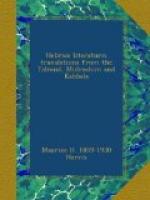Shechem, the son of Hamor, assembled girls together playing on tambourines outside the tent of Dinah, and when she “went out to see them,” he carried her off, ... and she bare him Osenath. The sons of Jacob wished to kill her, lest the people of the land should begin to talk scandal of the house of their father. Jacob, however, engraved the holy Name on a metal plate, suspended it upon her neck, and sent her away. All this being observed before the Holy One—blessed be He!—the angel Michael was sent down, who led her to Egypt, into the house of Potipherah; for Osenath was worthy to become the wife of Joseph.
Pirke d’Rab. Eliezer, chap. 48.
In Yalkut Yehoshua 9, Osenath is styled a proselyte; and indeed it might seem likely enough that Joseph induced her to worship the true God. The Targum of Jonathan agrees with the version of the Midrash above, while another tradition makes Joseph marry Zuleika, the virgin widow of Potiphar, and says that she was the same woman that is called Osenath (Koran, note to p. 193).
When Joseph’s brethren recognized him, and were about to kill him, an angel came down and dispersed them to the four corners of the house. Then Judah screamed with such a loud voice that all the walls of Egypt were leveled with the dust, all the beasts were smitten to the ground, and Joseph and Pharaoh, their teeth having fallen out, were cast down from their thrones; while all the men that stood before Joseph had their heads twisted round with their faces toward their backs, and so they remained till the day of their death; as it is said (Job iv. 10), “The roaring of the lion (Judah), and the voice of the fierce lion,” etc.
Vayegash, chap. 5.
The tradition of a legend in our possession says that Judah killed Esau. When? When Isaac died, Jacob and (the chiefs of) the twelve clans went to bury him; as it is written (Gen. xxxv. 29), “And his sons Esau and Jacob buried him.” In the Midrash it is, “And Esau and Jacob and his sons buried him,” which fits the legend better. Arrived at the cave, they entered it, and they stood and wept. The (heads of the) tribes, out of respect to Jacob, left the cave, that Jacob might not be put to shame in their presence. Judah re-entered it, and finding Esau risen up as if about to murder Jacob, he instantly went behind him and killed him. But why did he not kill him from the front? Because the physiognomy of Esau was exactly like that of Jacob, and it was out of respect to the latter that he slew Esau from behind.
Midrash Shochar Tov, chap. 18.
Tradition varies respecting the tragic end of Esau. The Book of Jasher (chap. 56, v. 64) and the Targum of Jonathan (in Vayechi) both say that Cushim the son of Dan slew Esau at the burial, not of Isaac, but of Jacob, because he sought to hinder the funeral obsequies, disputing the title to the sepulchre.
“Oh, that I had wings like a dove! for then I would fly away, and be at rest” (Ps. lv. 6). This is spoken of Abraham. But why like a dove? Rabbi Azariah, in the name of Rabbi Yudan, says, “Because all birds when tired rest on a rock or on a tree, but a dove, when tired of flying, draws in one wing to rest it, and continues her flight with the other.”




